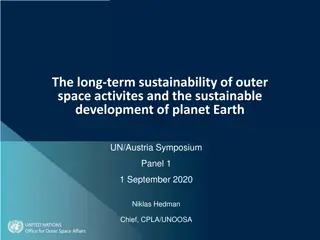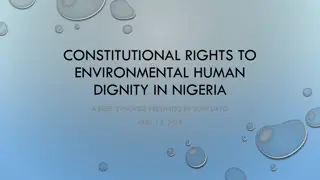Exploring the Intersection of Human Rights and Space Applications for Environmental Sustainability
This presentation delves into the relationship between human rights, environmental sustainability, and space applications for achieving Sustainable Development Goal 13. It discusses the principles of international environmental law, the promotion of a healthy environment, and the use of space technologies in monitoring and addressing climate change. The importance of upholding human rights principles in outer space activities is emphasized, along with the responsibility to ensure clean air and a healthy environment through space applications.
Download Presentation

Please find below an Image/Link to download the presentation.
The content on the website is provided AS IS for your information and personal use only. It may not be sold, licensed, or shared on other websites without obtaining consent from the author. Download presentation by click this link. If you encounter any issues during the download, it is possible that the publisher has removed the file from their server.
E N D
Presentation Transcript
Space Applications for SDG-13: General principles of international environmental law and space activities Climate Change and the Environment: Space Applications in the enforcement of Human Rights Jonathan Lim Project Co-lead - Jus Ad Astra 1
Outer Space sustainability Space applications in the promotion of SGD-13 Relationship between human rights and the environment Introduction Relationship between Human Rights and the SDGs 2
Human rights are rights inherent to all human beings, whatever our nationality, place of residence, sex, national or ethnic origin, colour, religion, language, or any other status. Human Rights Principles: 1. Universality 2. Indivisibility 3. Interdependence 4. Equality and non-discrimination 5. Participation and inclusion 6. Accountability What are Human Rights? 3
A. The use of space applications in the support and realization of human rights duties and obligations on earth. Intersection of Human Rights and Space B. The development of human rights values and principles in the advancement of human activities in outer space. 4
United Nations Framework Convention on Climate Change (UNFCCC) Climate Change and Human Rights Right to the enjoyment of a safe, clean, healthy and sustainable environment Human rights obligations relating to climate change 5
Obligation and responsibility to assume measures to ensure clean air and fulfill the right to a healthy environment. 2019 UNHRC Report on the Right to Clean Air Right to Clean Air BreatheLife Joint campaign including WHO, UN Environment Program, Climate & Clean Air Coalition (CCAC) Space applications: earth observation and air quality management, pollution monitoring 6
Encompasses environmental dimensions of right to life, health, food, water, sanitation, property, private life, culture, and non- discrimination. Right to a healthy environment has been recognized across 181 countries Right to a Healthy Environment Not integrated as part of SDGs Space applications: earth observation and tracking deforestation, growth, supporting disaster response monitoring urban 7
Intersection of space applications-human rights-climate change: o Space applications support the monitoring of environmental and human rights enforcement. Summary o The use of space applications to address climate change supports the realization of human rights o Space applications have contributed to the development of the precautionary principle 8
The End info@jusadastra.org www.jusadastra.org 9























